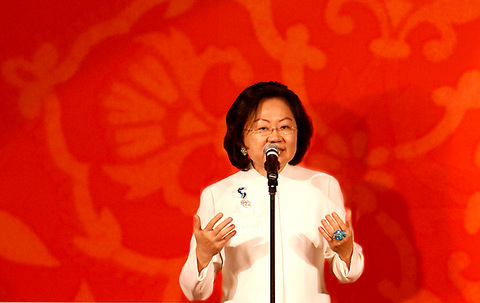The National Chiang Kai-shek Cultural Center (CKS Cultural Center) is turning 20 this year, and to celebrate the center will hold a series of performances by local and international acts at the National Theater and National Concert Hall. The center will also hold a 20-year retrospective on the evolution of Taiwan's foremost venue for the arts.
The Classic 20 series brings to the stage international heavyweights including Robert Wilson, Philip Glass and Tadashi Suzuki and musical performances by Bavarian Radio Symphony Orchestra and The German Opera of the Rhine. Performances by local groups will include Cloud Gate Dance Theater (雲門舞), Yang Li-hua Taiwanese Opera group (楊麗花歌仔戲), Performance Workshop Theater (表演工作坊) and New-Classic Dance Company (新古典舞團).
The retrospective is called Vitality Capsule of Art and will look at the dance, music, theater and opera performed at the NTCH over the past 20 years, with a view to the future.

PHOTO: NOAH BUCHAN, TAIPEI TIMES
"I hope to continue to bring international acts to Taiwan … as well as increase the profile of local artists abroad," said the recently appointed Chairperson for the CKS Cultural Center, Tchen Yu-chiou (陳郁秀), at a press conference on Thursday.
The board of directors elected the former Chairperson of the National Symphony Orchestra (NSO) and minister for cultural affairs to a three-year term.
But if this move is cause for celebration, the departure of Artistic Director, Ping Heng (平珩), leaves somewhat of a gap in the program.
After arriving in 2004, Heng oversaw the transformation of the center from a governmentally run operation to a public corporation. Though this change saw a one-third reduction in government funding for the center, the trade-off came in the fact that management was able to increase its control over content and staff.
With control over programming, Heng managed to increase the number of foreign artists holding workshops and performing in Taiwan. Recent examples include the New Circus performances given in October of 2006 and the recent lecture on the theater given by Robert Wilson in January.
But if Heng no longer works at the CKS Cultural Center, she doesn't plan on retiring. "I want to get back to my [dance] business, which I've neglected since becoming artistic director [in 2004]," she said when asked what she plans to do after leaving the NTCH.
Though programming for the center is the responsibility of Artistic Director, the majority of the performances at the National Theater and National Concert are rentals.
"Over the past three years, 30 percent [of the performances are] our own production and 70 percent are rentals," said Ann Liu (劉怡汝), deputy director of the CKS Cultural Center. This works out to 350 programs — with a total expense of roughly NT$280 million — sponsored by the NTCH, and 650 rentals.
But in terms of costs, the rental figure is slightly misleading as the fee for rentals is 30 percent lower than what it costs the NTCH. Consequently, the NTCH subsidizes the rental space.
The yearly budget to run the four theaters — the Concert Hall (2,000 seats), Recital Hall (350 seats), the National Theater (1,500 seats) and Experimental Theater (180 seats) — is roughly NT$985 million, including maintenance fees.

This is the year that the demographic crisis will begin to impact people’s lives. This will create pressures on treatment and hiring of foreigners. Regardless of whatever technological breakthroughs happen, the real value will come from digesting and productively applying existing technologies in new and creative ways. INTRODUCING BASIC SERVICES BREAKDOWNS At some point soon, we will begin to witness a breakdown in basic services. Initially, it will be limited and sporadic, but the frequency and newsworthiness of the incidents will only continue to accelerate dramatically in the coming years. Here in central Taiwan, many basic services are severely understaffed, and

Jan. 5 to Jan. 11 Of the more than 3,000km of sugar railway that once criss-crossed central and southern Taiwan, just 16.1km remain in operation today. By the time Dafydd Fell began photographing the network in earnest in 1994, it was already well past its heyday. The system had been significantly cut back, leaving behind abandoned stations, rusting rolling stock and crumbling facilities. This reduction continued during the five years of his documentation, adding urgency to his task. As passenger services had already ceased by then, Fell had to wait for the sugarcane harvest season each year, which typically ran from

It is a soulful folk song, filled with feeling and history: A love-stricken young man tells God about his hopes and dreams of happiness. Generations of Uighurs, the Turkic ethnic minority in China’s Xinjiang region, have played it at parties and weddings. But today, if they download it, play it or share it online, they risk ending up in prison. Besh pede, a popular Uighur folk ballad, is among dozens of Uighur-language songs that have been deemed “problematic” by Xinjiang authorities, according to a recording of a meeting held by police and other local officials in the historic city of Kashgar in

It’s a good thing that 2025 is over. Yes, I fully expect we will look back on the year with nostalgia, once we have experienced this year and 2027. Traditionally at New Years much discourse is devoted to discussing what happened the previous year. Let’s have a look at what didn’t happen. Many bad things did not happen. The People’s Republic of China (PRC) did not attack Taiwan. We didn’t have a massive, destructive earthquake or drought. We didn’t have a major human pandemic. No widespread unemployment or other destructive social events. Nothing serious was done about Taiwan’s swelling birth rate catastrophe.